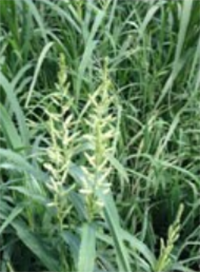 Barnyardgrass is a summer annual weed that can actively compete with corn and soybean crops for space and nutrients. Read the latest news and weed management information on barnyardgrass.
Barnyardgrass is a summer annual weed that can actively compete with corn and soybean crops for space and nutrients. Read the latest news and weed management information on barnyardgrass.
- Various types: Rough barnyardgrass1
- Scientific name: Echinochloa crus-galli1
- Grass or broadleaf: Grass
- Found in: AK, AL, AR, AZ, CA, CO, CT, DC, DE, FL, GA, HI, IA, ID, IL, IN, KS, KY, LA, MA, MD, ME, MI, MN, MO, MS, MT, NC, ND, NE, NH, NJ, NM, NV, NY, OH, OK, OR, PA, RI, SC, SD, TN, TX, UT, VA, VT, WA, WI, WV, WY1
- Germination timing: Barnyardgrass germinates from late spring until August. The weed species favors moist, compact soils with temperatures ranging from 75 to 90 F. Shallow tillage tends to provide the warmth and light that leads to germination.2
- Competitiveness: Barnyardgrass is a prolific seed producer. One plant left uncontrolled will lead to many seedlings competing with the crop next year.
Barnyardgrass appearing in fields early in the growing season can remove high amounts of potassium, phosphorus and especially nitrogen from the soil. Later-emerging plants are generally smaller and susceptible to crop shading, so barnyardgrass usually does not present a serious competitive threat late in the season.
Heavy stands of barnyardgrass can remove 60 percent to 80 percent of the soil nitrogen in a crop area.2
Fast facts:
- Like many annual grasses, barnyardgrass grows in clumps by rooting and branching at the lower nodes of the stems in a process known as tillering. Tillering occurs about 10 days after emergence.2
- The species can be identified by its distinctly flat stems and the absence of ligules, auricles and hairs. The stems are smooth and flattened, especially at the base of the plant. The leaves are generally smooth on both sides, but margins are rough and the prominent midvein usually has a reddish tint. The leaf collar area is light green to nearly yellow.
Resistance Statistics:*
According to WeedScience.org
- Herbicide classes
- Photosystem II inhibitors
- MD
- PSII inhibitors
- AR, LA, MO, TX
- Synthetic auxins
- LA
- ALS inhibitors
- LA
- Multiple resistance: two sites of action
- PSII inhibitors and synthetic auxins
- AR
- ACCase inhibitor and lipid inhibitors
- CA
- ACCase, ALS, PSII and cellulose inhibitors
- LA
*Resistance confirmation does not necessarily include all weeds and may vary among different areas of each state.
Weed management tips:
Joe Armstrong, field scientist at Corteva Agriscience, says:
- Barnyardgrass tends to emerge in the early part of the growing season, which makes it a competitive threat to a young, newly emerging crop.
- Controlling weeds with a preemergence herbicide before the crop reaches canopy gives the crop an advantage of the moisture, sunlight and nutrients available early in the season.
- Proper scouting to identify the problem, deeper tillage to reduce germination of barnyardgrass and escaped weeds are also effective measures growers can take to control barnyardgrass.
- Preemergence corn herbicides containing acetochlor, such as SureStart® II herbicide and Keystone® NXT herbicide, can control barnyardgrass early in the season so the crop grows into a clean field.
- In soybeans, Sonic® and Surveil® herbicides can be applied preemergence up to three days post-plant and each contains two modes of action to suppress barnyardgrass.
For postemergence control in corn and soybeans, growers can apply Durango® DMA® herbicide; however, it should be applied when the weeds are 4 inches or shorter in height.
Additional information:
More information can be found through these weed science resources:
1U.S. Department of Agriculture Natural Resources and Conservation Service. Plants Database. http://plants.usda.gov/core/profile?symbol=ECCR
2Lanini, W. T., and B. A. Wertz. Barnyardgrass. Penn State University. http://extension.psu.edu/pests/weeds/weed-id/barnyardgrass
Keystone NXT is a federally Restricted Use Pesticides. Durango DMA, Keystone NXT, Sonic, SureStart II, and Surveil are not registered for sale or use in all states. Keystone NXT and SureStart II are not available for sale, distribution or use in Nassau and Suffolk counties in the state of New York. Contact your state pesticide regulatory agency to determine if a product is registered for sale or use in your state. Always read and follow label directions.